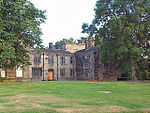Ripley Ville

Ripley Ville or Ripleyville was an estate of model houses for the working classes in Broomfields in the West Bowling ward of the City of Bradford in West Yorkshire, England. Started in 1866 the development was built for the industrialist, politician and philanthropist Henry William Ripley. It was intended as a commercial development of model houses but when completed in 1881 had many aspects of an industrial model village – although residency was not limited to Ripley's employees. It was the only model village in the Borough of Bradford and can be compared with Akroydon in Halifax, built by Ripley's friend and schoolmate Edward Akroyd, Saltaire and model housing schemes in other West Riding textile towns. Ripley Ville contained 196 workmen's cottages, a school and teacher's house, a church, allotment gardens and, on a separate site about a half-mile distant, a vicarage and ten almshouses which are still standing although all the other buildings had been demolished by 1970.
Excerpt from the Wikipedia article Ripley Ville (License: CC BY-SA 3.0, Authors, Images).Ripley Ville
Linton Street, Bradford West Bowling
Geographical coordinates (GPS) Address Nearby Places Show on map
Geographical coordinates (GPS)
| Latitude | Longitude |
|---|---|
| N 53.783 ° | E -1.746 ° |
Address
Linton Street
Linton Street
BD4 7EZ Bradford, West Bowling
England, United Kingdom
Open on Google Maps








